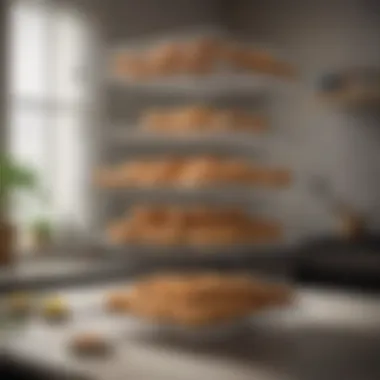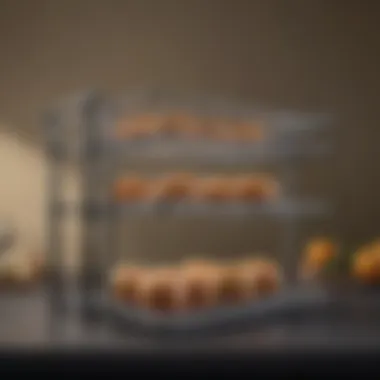Mastering the Versatile Tier Drying Rack


Intro
A tier drying rack serves a practical function in both home kitchens and professional culinary settings. Its design promotes optimal airflow, allowing for effective drying of various kitchen items, including fresh herbs, fruits, and vegetables. Unlike flat drying surfaces, these racks leverage vertical space, making them efficient and compact.
In this article, we will explore the functionality of these drying racks, their advantages, common challenges, and maintenance tips. Equipped with this information, food enthusiasts can make informed decisions about incorporating a tier drying rack into their culinary routines.
Design and Functionality
The tier drying rack is characterized by several tiers stacked vertically. This configuration aids in maximizing the use of available space, particularly in kitchens with limited countertops. Each tier allows air to circulate freely, aiding in quicker drying times.
Some common designs include:
- Stainless Steel Racks: Highly durable and resistant to corrosion.
- Wooden Racks: Offer aesthetic appeal but may require more maintenance.
- Plastic Racks: Lightweight and often less expensive, but may not be as sturdy.
The primary functionality of these racks extends beyond simply drying items. They can also be used for cooling baked goods, displaying fruits, or even organizing kitchen tools.
Advantages of Using a Tier Drying Rack
Choosing to use a tier drying rack offers several advantages:
- Space Efficiency: Vertical design conserves counter space.
- Improved Airflow: Aeration assists in reducing moisture accumulation, preventing bacterial growth.
- Versatility: Ideal for drying a variety of items, from herbs to pasta.
Users find that a tier drying rack often enhances the overall kitchen experience, making essential tasks more organized and streamlined.
Common Challenges and Solutions
While tier drying racks are beneficial, users may encounter challenges:
- Stability Issues: Ensure the rack is placed on a flat surface to prevent tipping.
- Cleaning Difficulties: Some racks can be cumbersome; opt for racks that can be disassembled for easier cleaning.
- Limited Capacity: Select a size that fits your needs to avoid overcrowding, which can slow down the drying process.
Effective solutions often involve careful selection of the rack and regular maintenance to ensure company longevity and cleanliness.
Maintenance and Care
Proper care extends the lifespan of a tier drying rack. Here are essential tips for maintenance:
- Regular Cleaning: Clean the rack after each use to prevent build-up.
- Inspect for Damage: Periodically check for any loose parts or rust if using metal racks.
- Store Properly: Keep the rack in a dry area to avoid unnecessary wear.
By following these guidelines, users can ensure their tier drying rack remains a valuable kitchen asset for years to come.
The End
In summary, the tier drying rack stands as a versatile tool in any culinary space. Its unique design and multifaceted applications promote efficient drying and organization. By understanding the functionality, advantages, challenges, and maintenance of these racks, users can elevate their cooking and food preparation processes, greatly enhancing their culinary experience.
Preamble to Tier Drying Racks
In the realm of culinary practices, the use of tier drying racks emerges as a critical consideration for both home cooks and professional chefs. Understanding their design, functionality, and application can vastly improve food preservation methods. Tier drying racks allow for efficient air circulation around items being dried. This is crucial as effective drying not only helps in food preservation but also enhances flavor concentration.
Definition and Purpose
A tier drying rack is a shelving system specifically designed to dry fruits, herbs, and other food items by utilizing multiple levels or tiers. This design elevates the food, allowing for better air flow from all sides. Its main purpose lies in preserving food while keeping it free from contaminants such as dirt and insects. The ability to dry large quantities of produce at once saves time and increases productivity in any culinary setting.
The tiered structure of the drying rack allows for various drying techniques, making it versatile. For example, one can use it for air drying or even for dehydrating fruits and vegetables with a heat source underneath. The purpose of these racks extends beyond mere drying; they can also be used to display food attractively.
Historical Context


The concept of drying food for preservation is not new; it dates back to ancient civilizations. People have been utilizing sunlight and air for centuries to extend the shelf life of their harvests. Over time, various cultures developed their own methods and tools for drying, leading to the evolution of specialized equipment such as tier drying racks.
In more recent times, the introduction of modern materials like stainless steel and hardwood has increased the functional capabilities of tier drying racks. These advancements allow for easier cleaning and enhanced durability. As gourmet cooking gained traction, tier drying racks became essential in commercial kitchens. Their practicality and efficiency turned them into a staple for chefs who require consistent quality in food preparation and presentation.
The increasing interest in home cooking and food sustainability further cements the relevance of tier drying racks in today's culinary practices. Food enthusiasts are now more inclined towards preserving seasonal produce at home, making tier drying racks highly beneficial.
Design and Structure
The design and structure of tier drying racks are pivotal in understanding their effectiveness and functionality. A well-constructed drying rack can significantly enhance the drying process while also optimizing space in both home kitchens and professional culinary environments. The combination of materials, configuration options, and overall build quality influences not just the efficiency but also the longevity of the product.
Materials Used in Construction
Metal
Metal drying racks are a popular choice due to their strength and durability. Often made from stainless steel, they resist rust and corrosion, making them ideal for environments with moisture. This characteristic ensures a long lifespan and reliability, essential for repeated use in drying food items. Metal racks typically provide superior stability, supporting heavier loads which might collapse weaker materials under stress. However, they may conduct heat, requiring caution when handling warm food.
Plastic
Plastic tier drying racks are lightweight and often more affordable. They come in various vibrant colors, which can add a decorative touch to a kitchen. The key advantage is their resistance to moisture and ease of cleaning, as they can often be wiped down quickly or rinsed under water. However, plastic may not support very heavy items and can warp if exposed to high temperatures, limiting their efficiency for certain tasks.
Wood
Wooden tier drying racks offer a rustic appeal to kitchen aesthetics. They are sturdy and can hold a good amount of weight while providing a heat-insulating property that is beneficial when drying warm baked goods. The natural material can absorb excess moisture, aiding in the drying process. However, wooden racks require more maintenance to prevent mold or warping due to humidity. It's crucial for users to treat wooden racks with food-safe finishes to ensure safety in food preparation.
Size and Configuration Options
Single Tier
Single tier drying racks are ideal for limited spaces or focused tasks. Their compact nature makes them suitable for drying smaller quantities, which is perfect for casual users or those with minimal drying needs. They are easy to store and can be placed on countertops without taking much room. However, a significant drawback is that single tier racks limit the amount that can be dried at one time, potentially needing multiple uses for larger jobs.
Multi-Tier
Multi-tier drying racks maximize drying capacity without needing additional floor space. They can hold multiple layers of food simultaneously, making them a great choice for bulk drying, especially for items like herbs or fruits. The vertical design optimizes airflow between the tiers, enhancing overall drying efficiency. One potential downside is that they may require more initial investment and can be heavier, which might be a concern for some users.
Overall, understanding the design and structure of tier drying racks reveals their importance in food preparation processes. Making informed choices about materials and configurations can significantly enhance the drying experience for both enthusiasts and professionals.
Operational Benefits
Understanding the operational benefits of a tier drying rack is essential for anyone looking to optimize their drying processes. This article presents a comprehensive look at several key advantages that illustrate why a tier drying rack is a critical tool in both home and professional kitchens.
Enhanced Airflow for Effective Drying
Airflow is crucial for effective drying. A tier drying rack allows for maximized air circulation between individual items, which significantly reduces drying time. The open design of these racks creates pathways for air to move freely, eliminating damp spots that could otherwise promote mold or spoilage. Using a tier drying rack can transform the drying experience for herbs, fruits, and baked goods, ensuring they maintain their quality.
Additionally, the height of tier racks makes it easier to position items for optimal exposure to air. Instead of piling items one on top of another, which can lead to uneven drying, a tier drying rack ensures each piece receives the necessary airflow. This design aspect is particularly important in humid environments, where moisture can linger.
Maximizing Space Efficiency
Space efficiency is another major operational benefit. In a kitchen where counter and storage space are often at a premium, tier drying racks allow for vertical storage of drying items. This vertical arrangement means more items can be dried at once without spreading them across valuable countertop space.
Furthermore, tier drying racks can be compactly stored when not in use, making them highly functional for users who may have limited kitchen storage. This practical aspect makes them ideal for anyone from home cooks to professional chefs wanting to streamline their workflow.
Versatility in Drying Techniques
Air Drying


Air drying is one of the most common and simplest methods that takes advantage of a tier drying rack. This technique relies on ambient air to remove moisture from food. It does not require any special equipment or energy consumption, making it an eco-friendly choice.
The key characteristic of air drying is its minimalistic approach. Users can fill the tiers with herbs or sliced fruits without any special setup. This method is beneficial for those wanting to retain the natural flavors and nutrients of food since it avoids the degradation that can occur with higher heat methods. However, air drying can have extended drying times, which might not be suitable for urgent needs.
Dehydrating
Dehydrating is another method that can be effectively used with tier drying racks. This technique uses controlled heat to remove moisture, resulting in foods with longer shelf lives. The primary advantage of dehydrating is its ability to produce more shelf-stable items compared to air drying. It is particularly popular for making dried fruits, vegetables, and jerky.
A unique feature of dehydrating lies in its efficiency and consistency. Users can regulate the temperature to achieve even results, reducing the chance of over-drying or burning. However, dehydrating requires access to a heat source, making it less straightforward than air drying. Thus, both methods have their place, depending on the specific needs of the user and the ingredients in question.
Practical Uses of Tier Drying Racks
Tier drying racks serve a vital function in both home kitchens and professional culinary environments. Their design promotes efficient utilization of vertical space, allowing for an increased volume of produce to be dried simultaneously compared to traditional flat drying methods. Understanding the practical applications of these racks can significantly enhance food preservation, accessibility, and flavor optimization. This section will delve into specific uses, including drying herbs and spices, fruits and vegetables, and baking applications. Each use provides unique benefits, making tier drying racks a versatile tool in the culinary toolkit.
Drying Herbs and Spices
Herbs and spices are essential components of culinary arts. Drying them at home using a tier drying rack can enhance their flavor profile and ensure potency. Fresh herbs contain moisture, which can lead to spoilage if not properly dried. The tier drying rack allows for the herbs to be spaced out evenly, exposing each leaf to optimal airflow. This significantly reduces the risk of mold, a common issue with traditional drying methods.
- Ensures uniform drying: Each tier allows for even air distribution.
- Keeps flavor intact: Dried properly, herbs maintain robust flavors.
- Preserves health benefits: Many herbs lose their nutritional properties when improperly dried.
To dry herbs, simply wash and thoroughly dry them before arranging them in a single layer on the racks. Check periodically for dryness. Once the herbs are crumbled easily, they are ready for storage.
"Properly dried herbs can last for several months, preserving their taste and health benefits."
Drying Fruits and Vegetables
Dried fruits and vegetables not only serve as healthy snacks but also enhance the flavors in recipes. The tier drying rack is particularly effective for this purpose due to its multi-layer design, which can accommodate a variety of items at once.
- Nutrient retention: Drying at lower temperatures helps preserve vitamins and minerals.
- Concentrated flavors: Removing moisture intensifies the natural sweetness of fruits.
- Extended shelf life: Properly dried produce can last significantly longer than fresh counterparts.
To dry fruits, slice them evenly and arrange them on the tiers. For vegetables, blanching may be necessary first. Monitor the drying process carefully and ensure that items are not too close together, which can lead to uneven drying or spoilage.
Baking Applications
In baking, tier drying racks find their place in tasks like cooling or drying layered products, such as cakes or pastries. The design aids in maximizing cooling space, ensuring that air circulates adequately around baked goods. This is particularly crucial for delicate items that require careful handling post-baking.
- Prevents sogginess: Adequate airflow helps avoid moisture trapping.
- Efficient use of space: A multi-tier rack allows handling multiple baked items at once.
- Enhances quality: Baked goods cool more evenly, contributing to texture and flavor.
To utilize the rack for cooling, simply place your baked items on the tiers once removed from the oven. Allow them to cool thoroughly, which assists with texture and helps to retain moisture without becoming overly dry.
By recognizing the practical uses of tier drying racks, culinary enthusiasts can elevate their food preparation and preservation techniques. This understanding helps them harness the full potential of their ingredients, whether they are drying herbs, preserving fruits, or managing cooling baked goods.
Maintenance and Care
Proper maintenance and care of a tier drying rack are essential to ensure its longevity and optimal performance. This is particularly significant given that these racks are often used in environments prone to moisture and food particles, which can lead to bacterial growth if not adequately handled. Focusing on maintenance can yield multiple benefits including improved drying efficiency and increased hygiene, crucial for culinary applications.
Cleaning Guidelines
Cleaning a tier drying rack prevents the build-up of molds, bacteria, and odors. Here are some practical steps to follow:
- Frequency: Clean the rack after each use to prevent residue accumulation. For deeper cleaning, consider doing so monthly.
- Materials: Different materials require different cleaning methods. For metal racks, a soft sponge with warm, soapy water will suffice. Plastic racks may need a gentle abrasive if there are tough stains. Wooden racks should be treated with care; avoid soaking them and use a damp cloth instead.
- Disinfection: After cleaning, disinfect with a solution of diluted vinegar or a food-safe sanitizer to ensure hygiene.
- Drying: Allow the rack to air dry completely before storage to prevent moisture retention, which can encourage mold growth.
Following these guidelines helps maintain the integrity of the materials while ensuring that the drying surface remains clean and safe for food.
Storage Recommendations


Proper storage of a tier drying rack is critical for preserving its condition. When not in use, consider the following practices:
- Location: Store the rack in a cool, dry place. Avoid areas with high humidity, such as near a sink.
- Disassembly: If the drying rack is modular, disassembling it for compact storage can prevent warping or damage.
- Covering: Use a breathable cover to protect it from dust while allowing air circulation. Avoid plastic coverings that can trap moisture.
- Accessibility: Keep the rack in a location that is easy to access for next use; this encourages regular use and promotes effective drying practices.
Maintaining and caring for a tier drying rack is not merely about prolonging its life but also enhancing its function as an efficient tool in cooking and food preservation.
By investing time in maintenance, users can enjoy consistently good results in their drying processes, ensuring food safety and preserving flavors to the fullest.
Common Challenges
When utilizing a tier drying rack, there are certain challenges that users may encounter. It is crucial to understand these issues to enhance the efficiency and effectiveness of the drying process. This section explores common challenges, specifically focusing on preventing mold and mildew, as well as managing inconsistent drying rates. Understanding these factors will lead to better results in drying various foods.
Preventing Mold and Mildew
Mold and mildew pose significant threats to the effectiveness of drying racks. They can wreak havoc on the food being dried and even lead to health risks, creating an unsanitary environment. To prevent mold and mildew, users should ensure proper airflow and cleanliness. Using a tier drying rack allows for ample space between each layer, facilitating airflow crucial for the drying process.
- Keep the drying space clean: Before using the rack, clean the area where the drying will take place. Dust and debris can harbor mold spores.
- Use food-safe materials: Some materials are more resistant to harboring mold compared to others. Metal and certain types of treated wood can offer better protection than untreated wood.
- Monitor humidity levels: High humidity can lead to mold growth. Use a dehumidifier or try to dry foods in a dry space to combat this.
It is essential to regularly check the food for any signs of mold. If detected, the affected food should be discarded immediately to prevent cross-contamination.
Managing Inconsistent Drying Rates
Inconsistent drying rates can be a frustrating challenge when using a tier drying rack. Variability in drying times can be influenced by several factors, including the thickness of food, air circulation, and temperature.
To manage inconsistent drying rates, consider the following strategies:
- Cut food uniformly: Ensure pieces are of similar size. This allows for even drying across all items on the rack.
- Rotate positioning: Occasionally rearranging the items in the tiers can help achieve more uniform drying. Items placed in the center might dry slower due to reduced airflow.
- Monitor drying conditions: Keep an eye on the temperature and humidity in the area. Ideal conditions lead to better consistency.
"Understanding these challenges and implementing effective strategies can transform how you use a tier drying rack, leading to better quality dried foods."
By proactively addressing these common challenges, users can maximize the utility of their tier drying racks. Mastering these aspects not only enhances the drying process but also improves the quality of the final product.
Innovations in Tier Drying Rack Design
Innovations in tier drying rack design play a crucial role in enhancing the efficiency and versatility of these kitchen tools. As culinary practices evolve, so do the needs of food enthusiasts. The advancements in design not only improve functionality but also address common issues faced by users. By focusing on specific elements such as technological advances and eco-friendly materials, the tier drying rack becomes a valuable ally in both home kitchens and professional environments.
Technological Advances
The introduction of technological advances in tier drying rack design has significantly benefited both casual cooks and skilled chefs. Various innovations have emerged to allow for improved airflow dynamics. For example, racks that incorporate adjustable tiers provide customization for different drying needs. Users can modify the spacing between layers, which encourages optimal air circulation around items being dried. This is vital for ensuring uniform drying, thereby preventing issues such as uneven moisture content.
Moreover, some modern drying racks are now equipped with sensor technology that monitors humidity levels. This feature enables users to achieve precise drying conditions tailored to the specific requirements of different foods. Fewer materials such as screen panels and quick-release clamps have become common due to their durability and effectiveness. The convenience of assembling and disassembling these racks also enhances user experience, making them easier to store when not in use.
Eco-Friendly Materials
As sustainability becomes increasingly important to consumers, the use of eco-friendly materials in tier drying racks is gaining traction. Manufacturers are experimenting with alternatives to traditional plastics and metals that can be harmful to the environment. Biodegradable plastics, bamboo, and recycled materials are now utilized in constructing drying racks. These materials not only reduce environmental impact but also add an aesthetic appeal to kitchen setups.
The choice of materials affects not just sustainability but also durability and efficacy. For example, bamboo racks are lightweight and naturally antibacterial, making them great options for dryinging herbs and spices. Users who prioritize sustainability find peace of mind knowing they are making responsible choices without sacrificing functionality.
"The evolution in design and materials of tier drying racks closely aligns with the growing trend towards sustainability and health-conscious cooking."
By integrating these innovations, users can enhance their culinary experiences while contributing positively to the environment.
Closure
The tier drying rack serves as a versatile tool for both home and professional kitchens. Its importance is underscored by its functionalities and benefits in culinary practices. In this article, several key elements were discussed, emphasizing how a tier drying rack can elevate the drying process of herbs, fruits, and even baked goods.
Summary of Key Points:
- The design and structure of tier drying racks vary, allowing users to select options that best suit their needs.
- Materials used range from metal to wood, contributing to durability and functionality.
- Maintenance, including cleaning and storage, is simple but essential for longevity.
- Common challenges such as mold and uneven drying rates can be managed with proper techniques.
The exploration of the future of tier drying racks in culinary practices reveals the potential for innovations. The integration of new technologies and eco-friendly materials will likely enhance user experience and performance. The demand for efficient drying methods aligns with contemporary culinary trends that value sustainability and food quality.
In summary, the tier drying rack is more than just a drying tool; it is an asset that encourages culinary exploration. Food enthusiasts should recognize its potential and integrate its use into their cooking practices for better outcomes.







